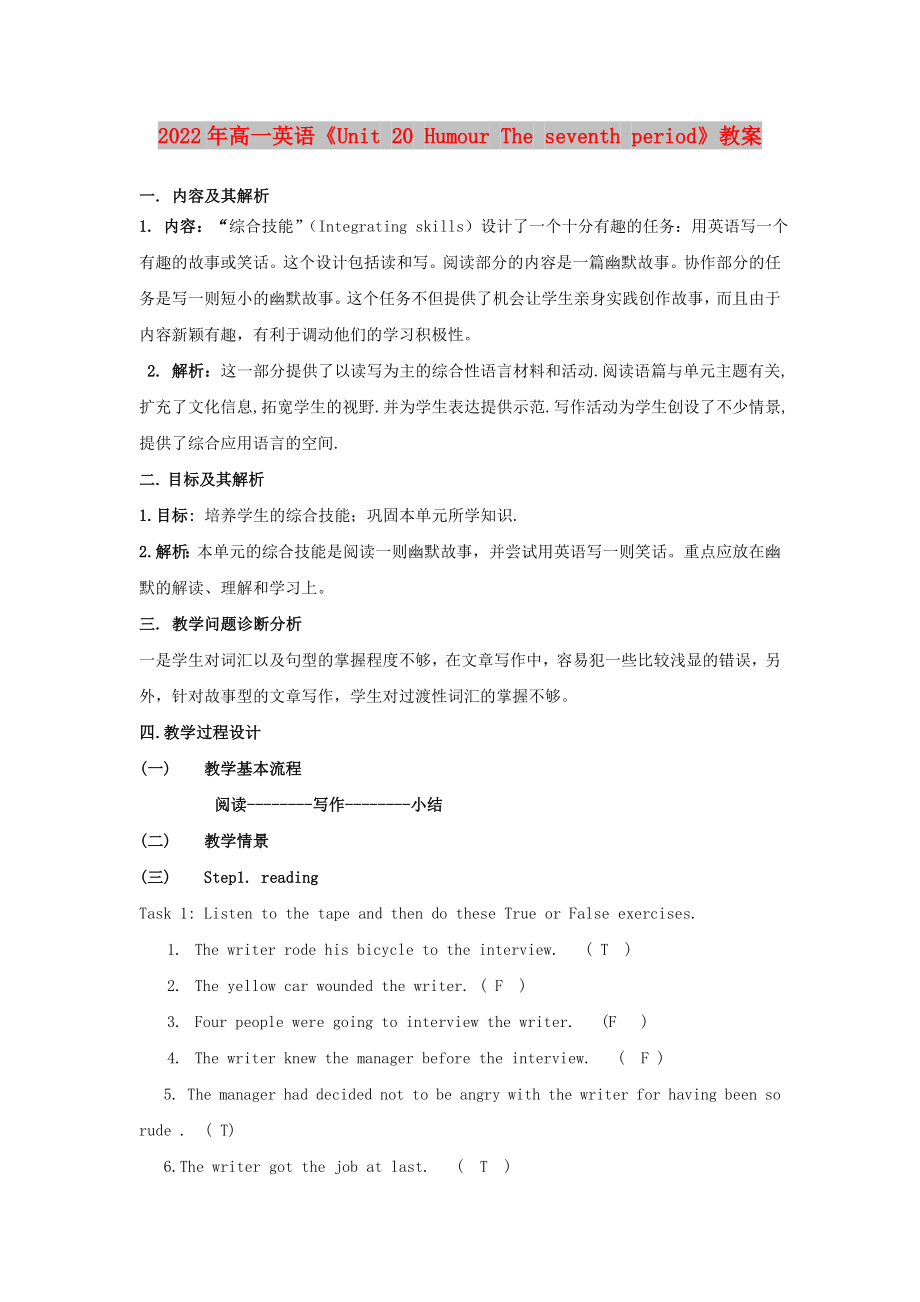《2022年高一英語《Unit 20 Humour The seventh period》教案》由會(huì)員分享��,可在線閱讀,更多相關(guān)《2022年高一英語《Unit 20 Humour The seventh period》教案(4頁珍藏版)》請?jiān)谘b配圖網(wǎng)上搜索�。
1���、2022年高一英語《Unit 20 Humour The seventh period》教案
一. 內(nèi)容及其解析
1. 內(nèi)容:“綜合技能”(Integrating skills)設(shè)計(jì)了一個(gè)十分有趣的任務(wù):用英語寫一個(gè)有趣的故事或笑話。這個(gè)設(shè)計(jì)包括讀和寫���。閱讀部分的內(nèi)容是一篇幽默故事�����。協(xié)作部分的任務(wù)是寫一則短小的幽默故事。這個(gè)任務(wù)不但提供了機(jī)會(huì)讓學(xué)生親身實(shí)踐創(chuàng)作故事�,而且由于內(nèi)容新穎有趣��,有利于調(diào)動(dòng)他們的學(xué)習(xí)積極性���。
2. 解析:這一部分提供了以讀寫為主的綜合性語言材料和活動(dòng).閱讀語篇與單元主題有關(guān),擴(kuò)充了文化信息,拓寬學(xué)生的視野.并為學(xué)生表達(dá)提供示范.寫作活動(dòng)為學(xué)生創(chuàng)設(shè)了不少情景,
2�����、提供了綜合應(yīng)用語言的空間.
二. 目標(biāo)及其解析
1.目標(biāo): 培養(yǎng)學(xué)生的綜合技能�;鞏固本單元所學(xué)知識.
2.解析:本單元的綜合技能是閱讀一則幽默故事�,并嘗試用英語寫一則笑話���。重點(diǎn)應(yīng)放在幽默的解讀、理解和學(xué)習(xí)上����。
三. 教學(xué)問題診斷分析
一是學(xué)生對詞匯以及句型的掌握程度不夠����,在文章寫作中�����,容易犯一些比較淺顯的錯(cuò)誤,另外���,針對故事型的文章寫作,學(xué)生對過渡性詞匯的掌握不夠���。
四.教學(xué)過程設(shè)計(jì)
(一) 教學(xué)基本流程
閱讀--------寫作--------小結(jié)
(二) 教學(xué)情景
(三) Step1. reading
Task 1: Listen to the tape and t
3、hen do these True or False exercises.
1. The writer rode his bicycle to the interview. ( T )
2. The yellow car wounded the writer. ( F )
3. Four people were going to interview the writer. (F )
4. The writer knew the manager before the interview. ( F )
5. The manager had decided not t
4�、o be angry with the writer for having been so rude . ( T)
6.The writer got the job at last. ( T )
Task 2: Fast reading- Fill in the blanks with the information you get from the passage.
Information The first meeting The second meeting
Time on the way to the
5�����、interview later (on time for the interview)
Place In the street an interview room
Relationship strangers interviewer / interviewee
Task 3.: Careful reading : read the passage carefully and then answer the following questions.
6����、
1.Why did the writer shout at the driver of the yellow car?
Because the car driver was careless and nearly caused an accident.
2.When did the writer next meet the driver?
At a job interview
3.What does she mean by the sentence: ‘…the last time we met I did most of the talking’?
The writer m
7���、eans that she shouted at the car driver without giving him a chance to say anything.(I remember that the last time we met I did most of the talking, so perhaps I should let you do the talking this time.)
4..What dose she mean by the sentence: ‘I say to everyone that I dare tell my manager exactly w
8、hat I think of him’?
She means that she once told her manager exactly what she thought of him,but she dose not admit that it was before he bee her boss.
設(shè)計(jì)意圖:通過該篇文章的閱讀���,讓學(xué)生掌握故事情節(jié)���,同時(shí)加強(qiáng)學(xué)生對過渡性詞匯��、以及相關(guān)句型的掌握��。
師生活動(dòng): 學(xué)生閱讀�����、教師提問��、學(xué)生回答
Step 2: Writing
Write a short funny story or a joke in English.
設(shè)計(jì)意圖:
9����、理論與實(shí)踐結(jié)合
師生活動(dòng): 學(xué)生練習(xí)
Step3 目標(biāo)檢測
1����、朝著…方向 in…direction 2����、把從自行車上撞下knock…off one’s bike
3�、沉默著in silence 4��、吃驚地in surprise 5�、把…看著/當(dāng)成 look on…as…
6����、因…對某人生氣be angry with sb. 7�、想到某人/某事 think of sb/sth.
8�����、有…目的 with the intention of…9�����、肯定地 with certainty
10(與某人)關(guān)系好be on good terms (with sb
10��、.)
設(shè)計(jì)意圖:讓學(xué)生熟記掌握文中的短語�����。
師生活動(dòng): 學(xué)生做,教師核對
配餐作業(yè):
一.基礎(chǔ)題(A組題)1.聽寫學(xué)習(xí)目標(biāo)中的詞匯
2. 單選題.
1. I think it no use _________ the problem any more.
A. to quarrel on B. to quarrel over C. quarrelling over D. quarrelling on
….
10. As I will be away for at least a year, I’d appreciate _____ from you now and t
11�����、hen _____ me how everyone is getting along.
A. hearing, tell B. to hear, tell C. hearing, telling D. to hear, to tell
Keys:CBBCCCDBC
設(shè)計(jì)意圖:讓學(xué)生通過做題�����,掌握文中的詞匯和句型。
師生活動(dòng): 學(xué)生做����,教師核對
二.鞏固題( B 組題) The Man behind Blue Jeans
? Levi Strauss died in 1902. He never married and left his mone
12��、y to his nephews. He left the world much more —— the jeans that so many people wear.
? 1.________ isn‘t a kind of dry goods.
?A. Thread B. Gold C. b D. Yarn
…
設(shè)計(jì)意圖:提高閱讀能力����。
師生活動(dòng):學(xué)習(xí)練習(xí)
三. 提高題(C 組題) 書面表達(dá)
Write a short funny story or a joke in English.
設(shè)計(jì)意圖:讓學(xué)生練習(xí)寫作故事或笑話���,掌握相關(guān)詞匯、句型���。
師生活動(dòng): 學(xué)生練習(xí)寫作,教師批閱并講評���。
Step 4 Summary
教學(xué)反思_______________________________________________________________________
 2022年高一英語《Unit 20 Humour The seventh period》教案
2022年高一英語《Unit 20 Humour The seventh period》教案

